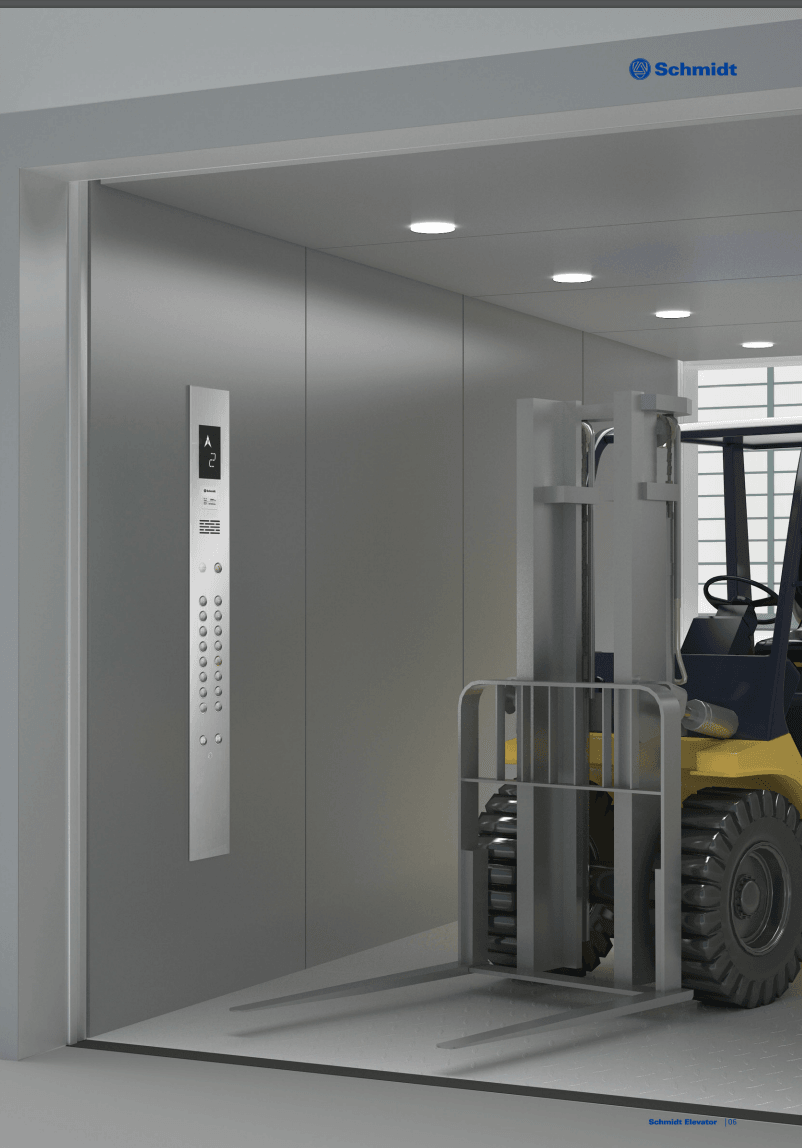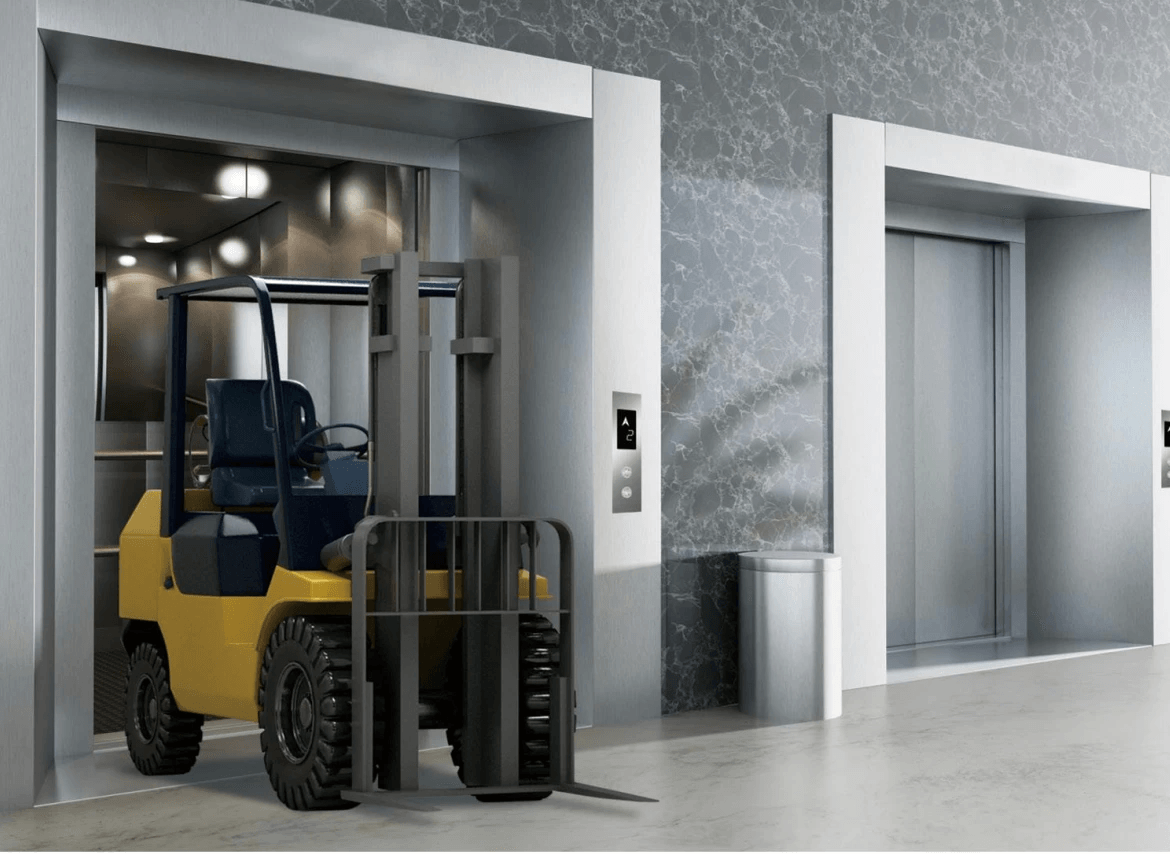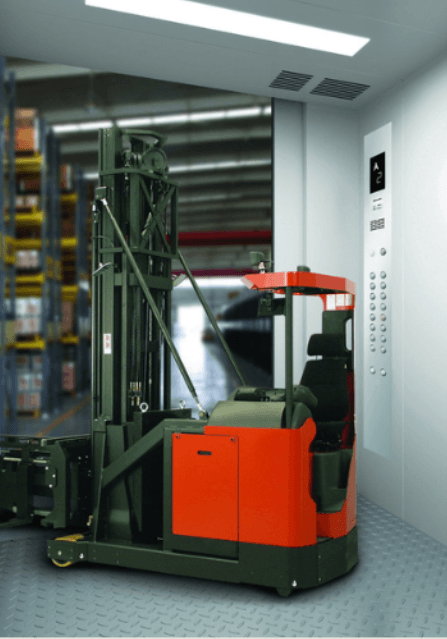Introduction

In the bustling world of commercial buildings, freight elevators play a crucial role that often goes unnoticed. These heavy-duty lifts are designed to transport goods and materials efficiently, making them indispensable for various industries. Understanding freight elevator dimensions is essential for businesses looking to optimize their operations and ensure safety in transporting goods.
Understanding Freight Elevators and Their Importance
Freight elevators differ significantly from household elevators, primarily in their design and capacity. While household elevators cater to personal transport needs, freight elevators are built to handle heavy loads, often accommodating large pallets or industrial equipment. This distinction highlights the importance of selecting the right type of elevator service based on specific business requirements.
Key Factors Influencing Freight Elevator Dimensions
When determining freight elevator dimensions, several key factors come into play, including load capacity, the type of goods being transported, and available space within a building. Additionally, industry regulations may dictate minimum size requirements to ensure safe operation. Understanding these factors is vital for companies planning to install or upgrade their company elevators.
Common Types of Elevators in Buildings
Buildings typically feature various types of elevators tailored for different purposes: passenger elevators for individuals, service elevators for staff and maintenance needs, and specialized freight elevators designed specifically for transporting goods. Each type has unique specifications regarding size and functionality that cater to its intended use. Recognizing these differences helps businesses make informed decisions about their elevator construction projects.
Freight Elevator Dimensions Explained

Understanding freight elevator dimensions is crucial for businesses that rely on transporting heavy goods within their facilities. Unlike household elevators, which prioritize comfort and aesthetics, freight elevators are designed with functionality and durability in mind. This section delves into the standard dimensions, influencing factors, and regulatory guidelines that shape freight elevator specifications.
Standard Dimensions of Freight Elevators
Freight elevators come in various standard sizes to accommodate different loads and building requirements. Typically, the dimensions range from 6 feet by 8 feet to larger configurations like 10 feet by 12 feet or more. These standard freight elevator dimensions ensure that companies can transport bulky items efficiently while adhering to safety regulations.
The height of these elevators is also a critical factor; most have a minimum clearance of around 8 feet to facilitate loading and unloading without hassle. In addition, the weight capacity usually varies between 2,500 to 5,000 pounds or higher for specialized models designed for heavier loads. Understanding these standard dimensions helps businesses select the right freight elevator for their specific needs.
Factors Affecting Freight Elevator Sizes
Several factors influence the size of a freight elevator tailored for a company's unique operations. First and foremost is the type of goods being transported; larger items require bigger elevators with ample space for maneuverability. Additionally, industry-specific requirements can dictate whether a standard size suffices or if custom solutions are necessary.
Another significant factor is the building's layout; limited space may necessitate compact designs without compromising functionality. The frequency of use also plays a role—high-traffic areas might benefit from larger models to facilitate quick movement of goods between floors. Ultimately, assessing these variables ensures that businesses choose an appropriate company elevator that meets their operational demands.
Industry Standards and Regulations
Organizations like the American Society of Mechanical Engineers (ASME) set forth guidelines ensuring safety and efficiency in elevator design and operation. Compliance with these standards not only guarantees passenger safety but also extends the lifespan of service elevators through regular maintenance checks.
Moreover, local building codes may impose additional requirements regarding weight capacities, door sizes, and emergency protocols that must be considered during installation or renovation projects involving freight elevators. Regular inspections are crucial as well; they help identify potential issues before they escalate into costly repairs or safety hazards down the line. Staying informed about these regulations enables businesses to maintain safe operations while maximizing their investment in freight elevator systems.
Comparing Freight Elevators to Household Elevators

Size Differences Between Freight and Household Elevators
Freight elevator dimensions are significantly larger than those of household elevators. While a typical household elevator may have a cab size ranging from 36 inches by 48 inches to about 54 inches by 80 inches, freight elevators can measure anywhere from 4 feet by 6 feet up to more than 10 feet by 12 feet or even larger. This size discrepancy allows freight elevators to accommodate bulky items like pallets or machinery that wouldn’t fit in a standard household elevator.
Moreover, the height clearance is another area where freight elevators shine; they often feature higher ceilings to facilitate the transport of tall goods. In contrast, household elevators are designed with residential aesthetics in mind and prioritize compactness over capacity. This fundamental difference makes it essential for companies needing a service elevator tailored for heavy loads to consider the right freight elevator dimensions.
Functionality and Load Capacities
The functionality of freight elevators far surpasses that of household models in terms of load capacities and intended use cases. Freight elevators are engineered specifically for heavy-duty tasks, often supporting loads ranging from 2,000 pounds up to an impressive 20,000 pounds or more depending on the model. On the other hand, most household elevators typically handle loads between 500 pounds and 1,500 pounds—perfectly suitable for transporting people but not ideal for commercial needs.
In addition to weight capacity, freight elevators usually come equipped with features such as automatic doors that can withstand frequent use without compromising safety or efficiency. Household models may offer similar conveniences but lack the robust design necessary for commercial applications. Therefore, understanding these functional distinctions helps companies choose between a company elevator that meets their operational needs versus a household option better suited for residential environments.
Installation Requirements for Each Type
When it comes down to installation requirements, both types of elevators have unique considerations based on their intended use and structural demands. Installing a freight elevator typically involves more complex engineering due to its heavier load capacities; this includes reinforced shafts capable of supporting significant weight during operation as well as specialized electrical systems tailored for industrial use.
Conversely, household elevator installations tend to be less complicated since they don’t need extensive infrastructure modifications—often fitting into existing home layouts with minimal disruption during installation processes. However, regardless of whether you’re opting for a service elevator or a residential model, it's crucial not only to follow local building codes but also ensure regular maintenance checks post-installation through professional elevator service providers.
In conclusion, comparing freight elevators with household models reveals significant differences in size dimensions suitable functionality along with varied installation requirements tailored towards specific uses—whether it’s moving large items across multiple floors or simply providing accessibility within homes.
Assessing Company Elevator Needs

When it comes to selecting the right elevator for your business, understanding freight elevator dimensions is crucial. A well-chosen freight elevator can enhance efficiency and streamline operations, especially in warehouses and manufacturing facilities. It’s essential to consider not just the space available but also the specific needs of your company.
Determining the Right Size for Your Business
Choosing the right size for a company elevator involves evaluating both current and future needs. Start by assessing what types of goods you’ll be transporting—heavy machinery, pallets of products, or even large furniture items will require different freight elevator dimensions. Additionally, think about how often you’ll use the service elevator; higher usage might necessitate a larger capacity to prevent bottlenecks in your operations.
Another factor to consider is building codes and regulations that may dictate minimum dimensions for freight elevators in commercial spaces. Compliance with these standards ensures safety and functionality while avoiding costly modifications later on. Ultimately, investing time in determining the appropriate size can lead to significant long-term savings and operational efficiency.
Freight Elevator Dimensions for Specific Industries
Different industries have unique requirements that influence freight elevator dimensions significantly. For instance, retail businesses often need elevators that accommodate large carts or display items, while food processing plants may require specialized designs for hygiene compliance and easy cleaning. Understanding these nuances helps ensure that your service elevator meets industry-specific demands effectively.
In healthcare facilities, elevators must be spacious enough to transport medical equipment safely without compromising patient care or safety protocols. Similarly, logistics companies rely on heavy-duty freight elevators with robust load capacities to handle pallets and bulk shipments efficiently. By tailoring your choice of freight elevator dimensions according to industry standards, you can optimize workflow while adhering to necessary regulations.
Custom Elevator Solutions from Schmidt Elevator Co., Ltd.
Schmidt Elevator Co., Ltd. specializes in providing custom solutions tailored specifically to meet diverse business needs across various sectors. Their expertise allows them to design freight elevators that perfectly align with your operational requirements while ensuring compliance with all relevant regulations regarding dimensions and load capacities. Whether you need a compact solution for a tight space or a high-capacity service elevator for heavy loads, they’ve got you covered.
Moreover, their commitment extends beyond just installation; they offer comprehensive maintenance services designed to keep your elevators running smoothly over time—because no one wants unexpected downtime due to repairs! With Schmidt's innovative approach towards elevator construction and design flexibility, businesses can enjoy peace of mind knowing they have reliable support at every step of their journey toward operational excellence.
Integrating Service Elevators in Buildings

When it comes to modern buildings, integrating service elevators is essential for efficient operations. These elevators are designed to facilitate the movement of goods and personnel, making them crucial for businesses that rely on heavy lifting and quick transportation. Understanding the dimensions and design considerations of service elevators can significantly impact their effectiveness in a commercial setting.
Dimensions and Design Considerations
Service elevator dimensions are typically larger than those of household elevators, accommodating bulky items and equipment with ease. When designing a service elevator, it's vital to consider not only the size but also the weight capacity to ensure it meets your company's needs. Additionally, factors such as door width, interior space layout, and loading dock accessibility play significant roles in determining how well the elevator integrates into your building's overall design.
The freight elevator dimensions must align with industry standards while also reflecting specific operational requirements unique to each business. For example, a restaurant may need an elevator that can handle large kitchen equipment or food deliveries efficiently. On the other hand, a warehouse might prioritize height clearance for pallets stacked high with inventory.
Importance of Elevator Service in Commercial Spaces
Elevator service is not just about moving people; it's about ensuring that businesses run smoothly without interruptions caused by malfunctioning lifts. In commercial spaces where heavy traffic occurs daily, reliable service elevators are vital for maintaining workflow efficiency and safety standards. When companies invest in high-quality service elevators tailored to their specific needs, they minimize downtime associated with freight elevator repairs or malfunctions.
Moreover, having dedicated service elevators helps separate goods transport from passenger movement—an essential aspect when considering building logistics. This separation enhances safety by reducing congestion during peak hours while ensuring that deliveries or maintenance tasks do not disrupt customer experiences in retail environments.
Maintenance and Repair Guidelines for Service Elevators
Regular maintenance is crucial for keeping service elevators operational and safe for use within any commercial establishment. Companies should establish routine inspections based on manufacturer recommendations to prevent potential issues before they escalate into costly freight elevator repairs or even accidents during operation.
In summary, integrating well-designed service elevators into buildings is fundamental for operational efficiency across various industries—from restaurants to warehouses—and requires careful consideration of dimensions alongside ongoing maintenance practices.
The Future of Elevator Construction
As we look towards the future, the construction and design of elevators are evolving at an unprecedented pace. Innovations in technology are reshaping freight elevator dimensions and capabilities, creating more efficient and versatile options for commercial spaces. With a focus on sustainability and user experience, the next generation of elevators promises to enhance both functionality and aesthetics.
Innovations in Freight Elevator Technology
The freight elevator is no longer just a box that moves goods from one floor to another; it's becoming an intelligent system designed for efficiency. Recent advancements include smart sensors that optimize load distribution, ensuring that freight elevator dimensions are used to their fullest potential while minimizing energy consumption. Additionally, automation is making its way into freight elevators with features like automatic doors and remote monitoring for elevator service, allowing companies to streamline operations significantly.
Moreover, technology integration is enhancing safety features within these elevators. For instance, real-time data analytics can predict maintenance needs before issues arise, reducing downtime associated with elevator repairs and keeping operations running smoothly. As businesses increasingly rely on efficient logistics solutions, these innovations will undoubtedly redefine what we expect from our company elevators.
Sustainable Practices in Elevator Manufacturing
Sustainability is becoming a pivotal concern in all industries, including elevator construction. Manufacturers are now prioritizing eco-friendly materials and energy-efficient designs when developing new models of service elevators or freight elevators. By using recyclable materials in their construction processes and implementing energy-saving technologies such as regenerative drives, companies can significantly reduce their carbon footprint while still meeting the demands for larger freight elevator dimensions.
Furthermore, sustainable practices extend beyond manufacturing to include installation processes as well; minimizing waste during installation ensures that both time and resources are conserved effectively. This shift not only aligns with global sustainability goals but also appeals to environmentally conscious consumers looking for responsible choices when selecting their company elevator solutions. As we move forward, expect more manufacturers to adopt these sustainable practices across all types of elevators.
Trends in Elevator Designs and Dimensions
The design landscape for elevators is also undergoing a transformation influenced by modern architectural trends and user needs. Elevators are being designed not just for functionality but also as aesthetic elements within buildings—think sleek finishes or customizable interiors that elevate (pun intended) the overall ambiance of commercial spaces! Freight elevator dimensions are adapting as well; larger cabins equipped with advanced loading systems cater to diverse industries requiring efficient transport solutions.
Another notable trend involves modular designs that allow customization based on specific business needs without compromising on space or capacity requirements—ideal for those seeking tailored service elevator options! Additionally, with urbanization on the rise, vertical transportation systems must adapt to high-rise buildings where traditional household elevators may not suffice due to space constraints or weight limitations associated with residential use versus commercial applications like freight transport.
In conclusion, the future of elevator construction looks promising with innovations paving the way towards smarter designs that prioritize efficiency while embracing sustainability—definitely something worth keeping an eye on!
Conclusion
As we wrap up our exploration of freight elevator dimensions, it's clear that understanding these specifications is crucial for businesses that rely on efficient vertical transportation. The right freight elevator not only enhances operational efficiency but also ensures compliance with industry standards. Whether you're comparing it to a household elevator or assessing your company's unique needs, the importance of choosing the correct dimensions cannot be overstated.
Key Takeaways on Freight Elevator Dimensions
Freight elevator dimensions vary significantly based on their intended use, load capacity, and building requirements. Standard sizes often accommodate large loads typical in warehouses and industrial settings, while customized solutions can cater to specific business needs. Remember, selecting the right freight elevator dimensions can streamline operations and improve safety in your facility.
The Role of Schmidt Elevator Co., Ltd. in Modern Elevators
Schmidt Elevator Co., Ltd. stands at the forefront of innovation in the elevator construction industry, offering tailored solutions for both freight and service elevators. Their expertise ensures that every company elevator meets stringent safety regulations while providing optimal functionality for various applications. With a commitment to quality and customer satisfaction, Schmidt Elevator Co., Ltd. plays a pivotal role in modernizing vertical transport systems.
Importance of Proper Elevator Installation and Maintenance
Proper installation and regular maintenance are essential for ensuring the longevity and reliability of any service elevator or freight elevator you choose for your business. Neglecting these aspects can lead to costly repairs or even accidents that compromise safety standards. Investing in professional elevator service not only protects your investment but also guarantees smooth operation throughout its lifespan.

